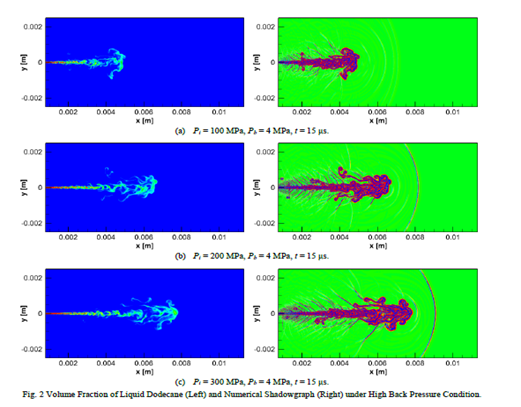Adbanced Numerical Simulation of Compressible Two-phase Flow of diesel atomization
JAXA Supercomputer System Annual Report April 2016-March 2017
Report Number: R16E0066
- Responsible Representative: Yuichi Matsuo(Aeronautical Technology Directorate, Numerical Simulation Research Unit)
- Contact Information: Takuji Kurotaki(kurotaki@chofu.jaxa.jp)
- Members: Takuji Kurotaki, Takahiro Sumi
- Subject Category: Aviation(Aircraft engine)
Abstract
Atomization of fuel of aeronautical engines is focused in because of fuel consumption and environmental issues. Information from CFD results is very helpful for solutions of them. The research of numerical simulation of compressible muti fluid flow is conducted to apply for these problems.
Goal
The research of numerical simulation technique to analyze the flow with high resolution through from subsonic to hypersonic velocity range in aeronautics will be made and especially, application to the compressible multi fluid flow in the aeronautical engines and diesel engines will be pursued.
Objective
By applying very robust WCS(Weighted compact scheme) which we developed in the previous research, high order compressible multi fluid flow chord will be developed. This is one of the fields of multi physics and is expected to be important. Finally, practical application to atomization of fuel of engines.
References and Links
N/A
Use of the Supercomputer
Super computer system can be used from simple problems for the validation of basic method to relatively large application for unsteady and multi dimensional problems. It is convenient for the speed up of development of numerical cord.
Necessity of the Supercomputer
This kinds of simulation deal with unsteady problems and in order for the reduction of computational time, the ability of handling of parallel computing is indispensable.
Achievements of the Year
Two main approach to the simulation of compressible multiphase flow are investigated; diffuse interface approach which treats the interface as mixture of both fluids and sharp interface approach with levelset method.
In the development of diffuse interface approach, basic equations are extended to six equation model and by considering the chemical equilibrium it became to possible to treat phase change such as cavitation.
In the development of sharp interface approach, new HLLC scheme which is extended to treat phase change models at the interface and it was confirmed that the problem of the cavitation collapse are simulated accurately.

Fig.1:Numerical results of high pressure atomizung jet by diffuse interface approach (Volume of fraction(left),shadowgraph(right),pressure of accumulator 100-300MPa)
Publications
N/A
Computational Information
- Parallelization Methods: Thread Parallelization
- Process Parallelization Methods: n/a
- Thread Parallelization Methods: OpenMP
- Number of Processes: 1
- Number of Threads per Process: 12
- Number of Nodes Used: 1
- Elapsed Time per Case (Hours): 2
- Number of Cases: 10
Resources Used
Total Amount of Virtual Cost(Yen): 10,609
Breakdown List by Resources
| System Name | Amount of Core Time(core x hours) | Virtual Cost(Yen) |
|---|---|---|
| SORA-MA | 0.00 | 0 |
| SORA-PP | 0.00 | 0 |
| SORA-LM | 0.00 | 0 |
| SORA-TPP | 0.00 | 0 |
| File System Name | Storage assigned(GiB) | Virtual Cost(Yen) |
|---|---|---|
| /home | 5.09 | 48 |
| /data | 78.01 | 735 |
| /ltmp | 1,041.67 | 9,826 |
| Archiving System Name | Storage used(TiB) | Virtual Cost(Yen) |
|---|---|---|
| J-SPACE | 0.00 | 0 |
Note: Virtual Cost=amount of cost, using the unit price list of JAXA Facility Utilization program(2016)
JAXA Supercomputer System Annual Report April 2016-March 2017


